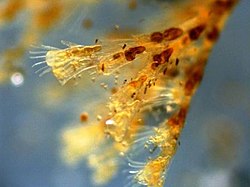This article includes a list of general references, but it lacks sufficient corresponding inline citations .(August 2025) |
| Campanulariidae | |
|---|---|
 | |
| Colony of Obelia sp. | |
| Scientific classification | |
| Kingdom: | Animalia |
| Phylum: | Cnidaria |
| Class: | Hydrozoa |
| Order: | Leptothecata |
| Family: | Campanulariidae Johnston, 1836 |
| Genera | |
See text | |
Campanulariidae is a family of hydrozoans in the phylum Cnidaria, or stinging-celled animals. [1] Campanulariidae is composed entirely of hydoids, a Greek term meaning "water animals" applied to the plant-like polyp colonies of the class Hydrozoa. All species of the Campanulariidae are aquatic in habitat, primarily inhabiting coastal regions and tidal pools.
Obelia contains probably the most well-known species of this phylum, and include four species. All are around 20–35 cm in height with a series of branches carrying the individual polyps. One species, Obelia longissima , is unique for its ability to produce obelin, a photoprotein which allows for bioluminescence.
The genus Laomedea includes such species as Laomedea angulata and Laomedea flexuosa , which are similar in appearance to the Obelia, though they are smaller and lack a medusa stage present in Obelia.